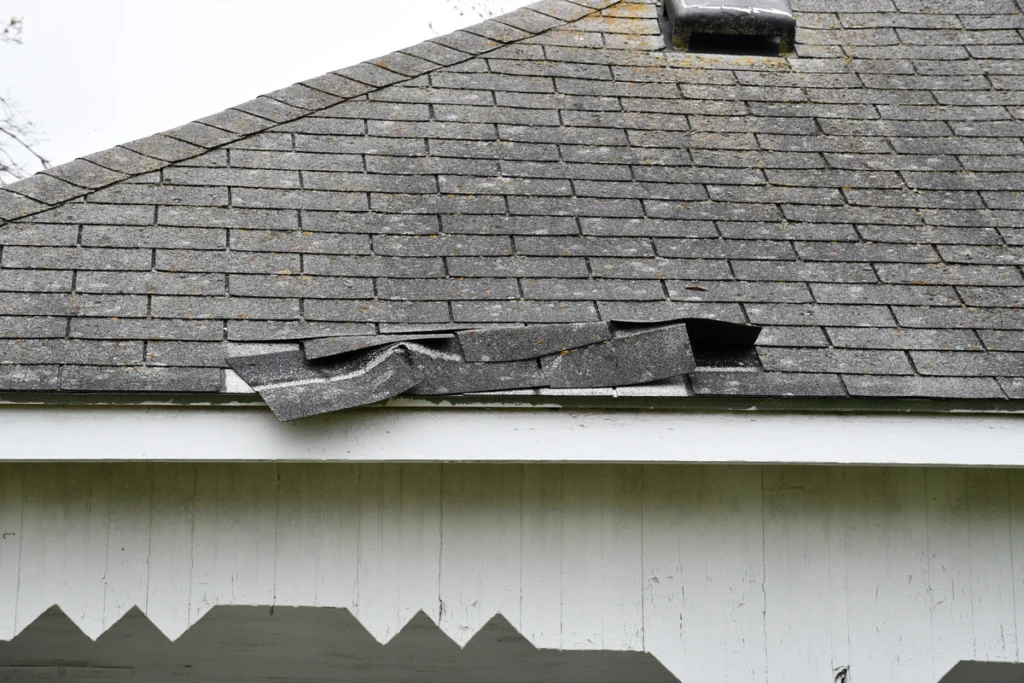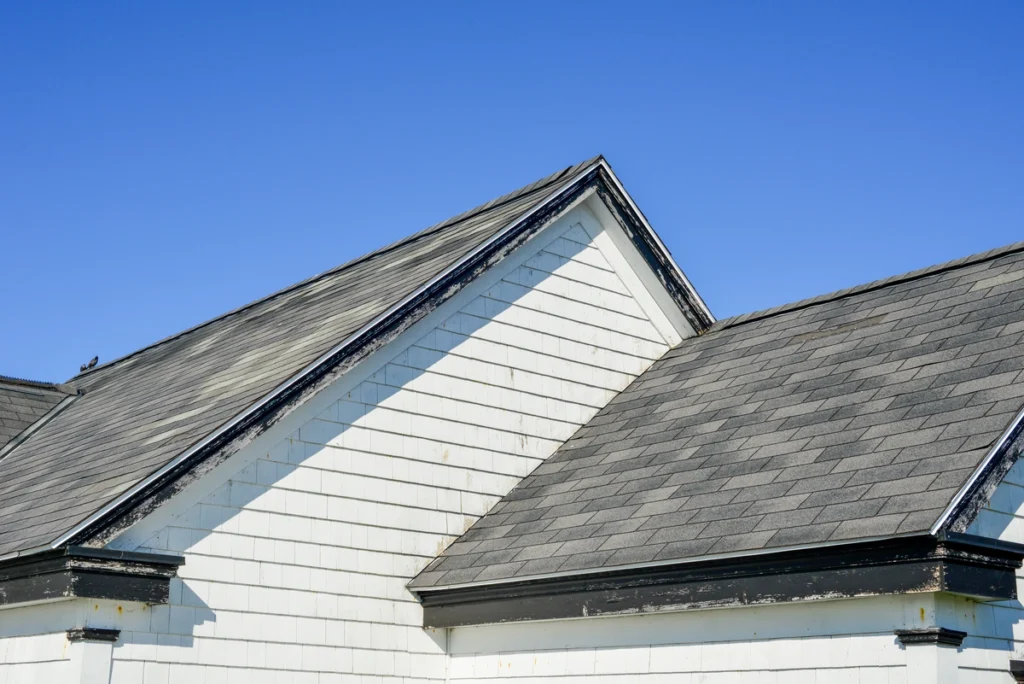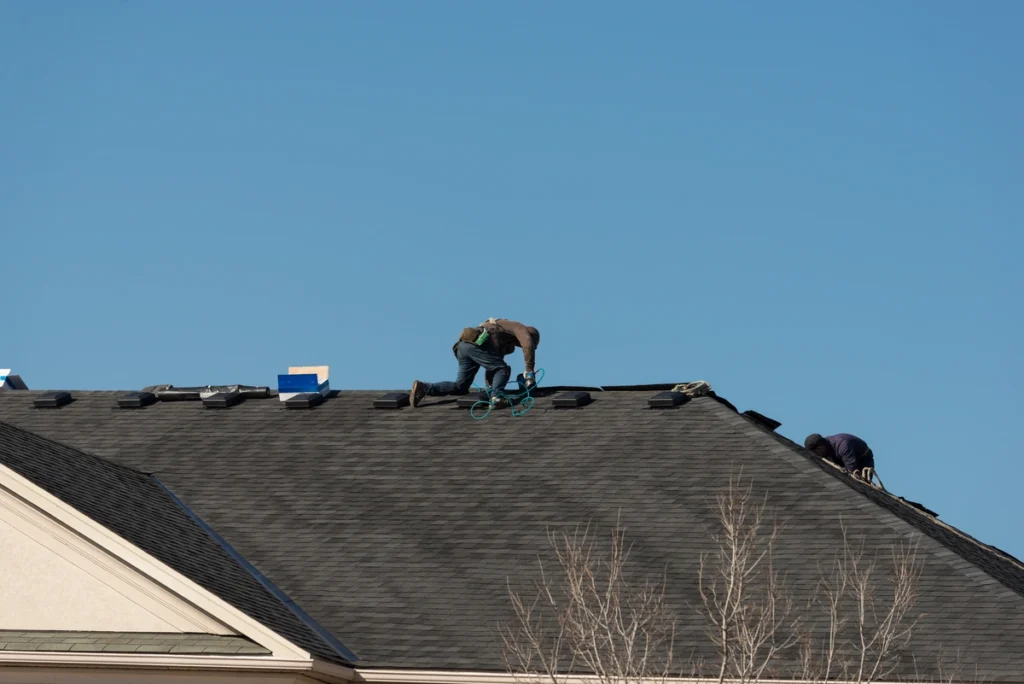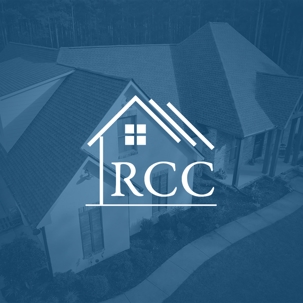Mother Nature’s force can wreak havoc on your home, particularly the roof, be it a severe downpour, high winds, or a major hail storm. In many cases, this storm damage is subtle, and you may not notice anything wrong at first glance—but looks can be deceiving.
Hidden damages, if left unchecked, could lead to costly repairs in the future. But how do you identify these hidden signs? No need to climb that ladder just yet!
In this blog post, we’ll uncover the most common signs of storm damage that every homeowner should know. This information will allow you to address the issue before it becomes a bigger problem.
Common Signs of Storm Damage

As storm season intensifies, look for common signs of storm damage that can wreak havoc on your property.
Craters on the Roof
Among the often-overlooked signs of damage are craters on your roof, a result of strong winds, falling limbs, or merciless hail events.
These dents and divots on asphalt shingles serve as entry points for water leaks. Imagine your home weathering heavy rain after a severe storm; with crater-filled shingles acting as tiny sieves, moisture penetration becomes inevitable.
Next time a severe wind event hits, and you’re cleaning up debris at ground level, remember that some destructive fallout isn’t immediately visible. If there’s rainwater pouring into your home and torn-off shingles littering your yard, of course, reach out immediately for emergency roof repairs.
But even if all seems well, it’s important to take a closer look.
Blown Off or Cracked Shingles
High winds from severe storms can wreak havoc on your home’s roofing system, with one of the most obvious signs being blown off or cracked asphalt shingles.
For instance, following a storm with high winds, you might spot missing shingles scattered around your yard—a clear indication of wind damage. But it isn’t just about the completely torn-off; partially lifted or curled wood shingles may also invite water leaks and subsequent moisture penetration into your roof deck.
Clogged Gutters
High winds and severe weather can wreak havoc on your home’s gutter system. One of the most obvious signs of roof storm damage is clogged gutters. Powerful gusts can pick up loose debris, such as falling branches or tree limbs, hurling them onto your roof with significant force.
When a major storm hits, broken pieces from asphalt shingles and other roofing materials often find their way into the gutter system, contributing to even more obstruction.
Blocked or broken gutters fail to properly channel heavy rain away from your house, leading to leaks and water damage in less visible areas like basements and crawl spaces.
If you notice staining on siding or downspouts, it’s a sign that overflowing water has been forced off course by some barrier inside those crucial conduits for runoff.
Furthermore, any sagging along the sides indicates excess weight from accumulated material occupying precious space meant only for swift-moving precipitation.
Leaks Inside the Home
One of the most common signs of storm damage that homeowners should be aware of is leaks inside the home. After a severe storm, it’s common for water to find its way into your house through damaged roof areas or poorly sealed windows and doors.
When inspecting your home for storm damage, watch for any yellowish stains on the ceiling or walls. These stains are often indicative of roof leaks caused by wind damage.
Staining or discoloration on walls, ceilings, and floors can also signify water damage inside the home.
Steps To Take After Recognizing Storm Damage

Once you have recognized storm damage to your property, it’s important to take immediate action. The following crucial steps can make all the difference in safeguarding your property and starting the recovery process.
Assess the Damage
After a storm hits, assess the damage to your home as quickly as possible. This assessment will help you determine the extent of repairs needed and ensure no further damage occurs.
One of the most obvious signs of storm damage is visible roof damage, such as missing or cracked shingles. These can be caused by high winds or falling debris during a severe storm.
Inspect your roof for any signs of trouble to assess the damage properly. Look out for loose debris, blown-off shingles, or even dented areas on metal roofs caused by hailstorms.
It’s important to remember that assessing storm damage requires expertise, and what might appear minor at first glance could indicate more significant underlying problems.
Document the Damage
After recognizing storm damage to your property, it’s crucial to document the extent of the damage as soon as possible. This documentation will help you communicate effectively with your insurance company and serve as evidence for any potential claims.
Take photographs or videos that capture all visible signs of damage, including cracked shingles, fallen debris, and water leaks inside your home. Be thorough in your documentation, and capture both close-up shots and wide-angle views.
Additionally, identify areas where further damage may have occurred due to the initial storm impact. This could include weakened roof supports or compromised gutter systems.
Contact Your Insurance Company
It’s crucial to inform your insurance company about the damage as soon as possible so that they can initiate the claims process and provide assistance with repairs.
When you contact the company, ensure all the necessary information is ready. Provide them with accurate details about when and where the storm occurred and a comprehensive description of the damage sustained by your property.
By promptly reporting the storm damage, you increase your chances of receiving proper compensation for repairs and associated costs.
Remember that it’s always beneficial to review your homeowners or renters insurance policy ahead of time to familiarize you with what types of storm damages are covered.
Hire a Professional for Repairs

While it may be tempting to attempt DIY fixes, hiring an expert is best to ensure the job is done right and prevent further damage.
By hiring a professional, you can have peace of mind knowing that they will use high-quality materials and adhere to industry best practices during the repair process. They also have access to specialized tools and equipment for effectively addressing storm damage.
Conclusion
Awareness of the common signs of storm damage is crucial for homeowners to protect their property and ensure the safety of their loved ones. Craters on the roof, blown-off or cracked shingles, clogged gutters, and leaks inside the home are all red flags that should not be ignored.
Take immediate action if you notice these signs after a severe storm hits your area. Assess the damage and document it thoroughly before contacting your insurance company. Be sure to hire a professional roofing contractor, such as Rankin County Custom, for repairs to prevent further damage and restore your roof to its original condition.

